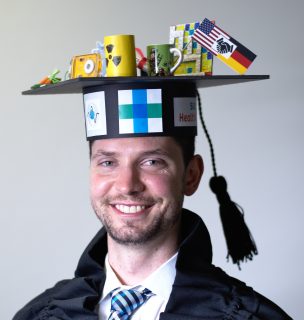James Sanders
Single photon emission computed tomography (SPECT) is a medical imaging
modality used to visualize the distribution of radioactive tracers in a patient’s body.
While SPECT’s utility as a diagnostic modality has long been established, its use
for planning and managing nuclear medicine therapies has grown in recent years.
With these new applications comes a need for absolute quantitation of the amount
of radioactivity in tissues. When small, detailed structures are being imaged, a
major confounding factor for the quantification task is respiratory motion, which blurs
images and leads to underestimation. This thesis seeks to contribute new methods
for quantitation and respiratory motion management in SPECT imaging.
We first briefly describe the underlying principles that enable SPECT image formation,
as well as physical nonidealities and physiological aspects of respiratory motion
that confound it. Following this, we introduce methods for analytical and iterative
image reconstruction before surveying the techniques that have been developed
to correct for these confounding processes.
A benefit of these corrections is the enabling of absolute quantitation, and in the
next chapter we propose a quantification protocol for Lu-177, an isotope frequently
used in radionuclide therapies. After characterizing the protocol in a phantom experiment
meant to establish a parameter set offering a favorable bias-variance trade-off,
we validate the results with an in vivo patient study. We found that our protocol
delivered mean errors relative to truth in the bladder of 10.1%.
We then move to the task of respiratory motion management, the first step of
which is obtaining a surrogate signal representing a patient’s respiratory state over
time. After describing five data-driven methods for extracting such a signal, we
compare their performance in a phantom experiment and with a collective of cardiac
patient scans. We then expand upon this by taking the best-performing method —
a dimensionality reduction-based approach using Laplacian Eigenmaps (LE) — and
augment it with post-processing steps to make it fit for fully-automated operation in
clinical practice. Following this, we present results from a follow-up patient validation
on a larger collective with 67 scans indicating that the LE-based approach correlates
well with a clinically-accepted sensor-based method.
To provide an independent assessment of surrogate signal quality, we then analyze
respiratory-gated acquisitions from two types of SPECT scans used for therapy
planning: selective internal radionuclide therapy (SIRT) planning scans with Tc-99m-
MAA and dosimetry acquisitions for Lu-177-based radionuclide therapies. The results
show that data-driven LE surrogates allow recovery of meaningful respiratory motion,
and we report preliminary results indicating the type of clinical benefits that
compensating for this motion might possibly provide.
As a final contribution, we propose an algorithm to improve the robustness of respiratory
motion estimation in SPECT projections using a sequence-based estimation
scheme and a motion model driven by the surrogate signal itself. In a simulation
study, we show that our proposed Sequence-based Motion Model (S-MM) algorithm
reduces estimation variance compared to two comparison methods. Furthermore, in
a collective of 20 patient Tc-99m-MAA liver scans, S-MM reduces respiratory motion
blur more consistently and to a greater extent than the comparison methods. We
conclude the thesis with a summary and outlook of possible future work.
